|
 |
|
 |
|
 |
 |
| |
16:9 in English: The Big Swede: The Tribulations of a Dane in 1920s Hollywood
By LAURA PETERSEN BALOGH
The story of Karl Dane is a Cinderella story gone horribly wrong. A simple working class dreamer from Copenhagen, he came to America and achieved fame and fortune in 1920s Hollywood. But he became an outsider almost overnight and ended up operating a hot dog stand just outside of the studio, where he had once been a star. This first-time ever analysis will take a look at this neglected star and his Nordic screen characterizations. Was Dane truly a talented artist or was he simply an empty cipher, guilty of perpetuating negative Scandinavian stereotypes that existed in this era?
The name of Karl Dane, if it is remembered at all, brings to mind Hollywood scandal and tragedy. A popular comic star and character actor, Dane’s Scandinavian accent was judged unsuitable for sound films, and he committed suicide by gunshot in 1934.
In the seven decades since Karl’s death, no one has ever attempted a serious study of his screen characterizations. Known as “The Big Swede” or “The Great Dane” on the MGM studio lot and by American film audiences who could not really differentiate between the Nordic countries, he was best known for his tall (6’3 ½”), gawky, rubber-faced look, and his lumbering, lovable, somewhat soft-headed portrayals (fig. 2).
The Fact and the Legend
According to Hollywood legend, Karl Dane was a simple studio carpenter when director King Vidor discovered him, and gave him a starring role in 1925’s smash war film, The Big Parade. However, this was complete fiction. The way to fame was a long and arduous one for Karl Dane, who was nearly 40 when he achieved true stardom.
The son of a glovemaker, Karl was born Rasmus Karl Therkelsen Gottlieb on October 12, 1886, in Copenhagen. After marrying and fathering two children, he immigrated to the United States in 1916, due to high unemployment caused by the war.
Settling in Brooklyn, he supplemented his factory work by taking jobs as an extra and stuntman. His imposing and unconventional looks got him noticed, and he was cast in the first propaganda picture in America, My Four Years in Germany. In this film, he was cast as the giant German Chancellor von Bethmann-Hollweg, a role he would reprise in two other films. Germany, which still survives today, reveals a very different Karl Dane than in later films: elegant, aristocratic, and urbane, he brings to mind a young Christopher Lee.
Karl immediately moved on to serials, working with director Joseph A. Golden and motorcycle daredevil Charles Hutchison in The Wolves of Kultur (1918), and The Whirlwind (1919), among others. In Kultur, Karl played the main henchman, Carter, an unusually brutal, sadistic, woman-beating villain. Karl’s simple, naturalistic portrayal of the character made him all the more frightening.
Karl quit films for awhile after becoming discouraged with the quality of his roles, and became a chicken farmer in southern California. But Hutchison enticed him back to the dramatic life, engaging him in another serial. This exposure could not have come at a more opportune time. MGM Director King Vidor was then casting for a new film, The Big Parade, which followed the adventures of three men of differing backgrounds, who are sent to the front and become friends. Matinee idol John Gilbert and Tom O’Brien played the parts of spoiled rich boy and a tough New York bartender, respectively. But the part of the tall, gangly, devil-may-care “Slim” had yet to be cast. |
|

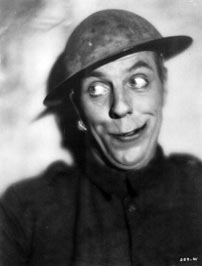
Fig. 2: Karl in The Big Parade. |
|
| |
Robert McIntyre, MGM Casting Director, knew Karl from his days as an extra, and saw him in the new Hutchison serial. He knew that Karl was just right the right “type” for the part of Slim and recommended him to Vidor (fig. 3). It was this legendary director who thought up Karl’s comic trademark of tobacco chewing and spitting. Karl reported to work at the studio each day with a piece of licorice in his mouth, and it dawned on Vidor to make this personal idiosyncrasy part of the film, but he replaced the candy with the tobacco (a fig was actually used on the set rather than the real thing). There is a comic scene in the film in which the troops are leaving the French farmhouse in which they were billeted, and are gathering up their belongings. As Slim is taking one last look in the garret, he spies a lone lit candle that remains. Rather than go back up the ladder, he simply spits a well-aimed stream of tobacco juice in its direction, handily extinguishing it.
Catapult to Fame
When the film debuted in November 1925, many reviewers declared that Karl stole the picture away from Gilbert, and that he had that rare ability to make audiences both laugh and cry. Indeed, although the first half of the film employed many comic scenes, the second half was outright drama and gritty battlefield scenes. Slim’s death scene in No Man’s Land is still disturbing and difficult to watch today. As Slim slowly dies on the battlefield, separated from his desperate friends who can hear him moaning in pain, his earlier comic grotesqueries fall away, exposing a child-like vulnerability. Audiences responded very powerfully to Karl, and almost overnight, he became beloved by thousands of people. |
|
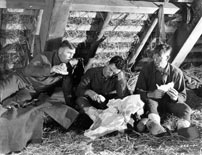
Fig. 3: Tom O’Brien, John Gilbert and Karl. |
|
| |
Karl was promptly signed to an MGM contract and earned $100 per week, which was eventually raised to $1,500 per week at the height of his fame. Many people took notice of Karl, especially the legendary actress Lillian Gish, newly signed to the studio and looking for a new project and the proper co-stars to appear with her. She saw an early screening of The Big Parade and immediately requested King Vidor as her director and almost all of the principals for La Boheme, based on the opera. Karl had a small part, as an elderly building superintendent who befriends Gish’s tragic character Mimi, but he made the most out of it, and Gish was impressed. He was therefore awarded a bigger role in her next picture, The Scarlet Letter based on Nathaniel Hawthorne’s classic novel (fig. 4).
Letter was a real Scandinavian production. Not only did Karl co-star as Master Giles, the town’s goofy but respected barber-surgeon, but it was directed by Victor Seastrom and starred Lars Hanson, both from Sweden. Again, although the role was essentially a comic one, Karl’s character is the only person who has the moral courage to fight back against those who persecute Hester. He continuously and hilariously feuds with the malicious gossip, Mistress Hibbens (Marcelle Corday), whose spitefulness constantly keeps poor Hester in trouble.
One of the running themes in Karl’s films was his character’s refusal to play by the rules and accept injustice. Letter is a great example of this. In one of the film’s finest comic scenes, Karl sneaks into Mistress Hibbens’s home as she dozes; he dons her bonnet and shawl, and positions himself by an open window, where he makes hilariously unflattering comments about two of the town officials, who conveniently happen to be passing by. As a result, Hibbens is sentenced to be ducked the very next day, to the delight of the entire town.
Karl also takes similar action in Clarence Brown’s The Trail of ‘98 (1927), a film concerned with the Alaskan Gold Rush of 1898. Karl portrayed Lars Petersen, a Swedish farmer who goes west to seek his fortune after escaping an abusive wife. After later striking gold with some friends, he rushes to the Gold Commissioner’s office to stake his find, only to find that Jack Locasto (Harry Carey) has crookedly jumped his claim and stolen what is rightfully his. His friends are ready to give up, but Lars will have none of it. He literally goes berserk, and proceeds to tear the place apart with his bare hands, ripping apart walls, doors, tables and chairs, and beating up the miscreants. As a result, the villains are cowed, and Lars gets the fruits of his labors and is triumphant. It is truly a cheer-inducing scene even today, and Karl’s actions appear to represent what the people in the audience would have liked to do if they had the gumption and strength. |
|
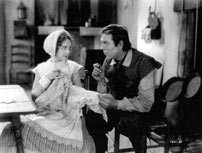
Fig. 4: Lillian Gish and Karl. |
|
| |
Beyond Stereotype
Some of Karl’s characterizations employ some then common Scandinavian stereotypes. The hulking Lars, for example, is dominated by a tiny, shrewish wife, (played by frequent co-star Polly Moran). This fit the then-popular image of Scandinavian men as passive and rather emasculated types. This image predated Karl’s time, starting back in 19th Century American Vaudeville. Lars’s oft-repeated cry of “Yumpin Yiminy!” was evidence of this stereotype, as is the character’s dim-wittedness. At one point in the film, a crooked peddler sells him a handy device to protect himself in the wilds of Alaska from flying insects. Called “Sure Death for Mosquitoes” it is simply two small wooden blocks with which to crush their tiny bodies! Of course, the highly gullible Lars eagerly buys this product (fig. 5). However, he is sharp enough to realize the man has cheated him out of his change, and promptly goes after the hapless thief, demanding the missing coins, and giving him a boot in the derriere as he scampers off!
This stereotypical dopiness exists in other of his films as well, but Karl fleshed out his characterizations so they were three-dimensional. In the baseball-themed Slide Kelly Slide (1927) his character, Swede, is no cipher. Despite his gruffness and softheadedness, he is also caring and compassionate. Together with his pal, fellow Yankees team member Kelly (played by William Haines), they take in a homeless and hungry waif (Frank “Junior” Coghlan Jr.), and “adopt” him, making him the team’s batboy. This film also shows a very sensitive, emotional side to Karl’s range as an actor. In one touching scene, Mickey rejects and insults poor Swede, who has bought him a hideously vulgar suit of clothes (another Nordic stereotype). However, Kelly chides the boy and makes him apologize to the big guy, who has broken into tears and fled the room. Their reconciliation scene, in which Swede takes the little boy into his arms, is poignant indeed and shows that Karl was a well-rounded performer fully capable of so much more than straight comedy.
Karl was in fact in such demand that other studios were requesting his services. MGM loaned him out to United Artists in 1926 to make The Son of the Sheik with the legendary Rudolph Valentino. This would be the Great Lover’s last role before his own tragic death. Karl played Ramadan, friend and loyal manservant to Valentino’s Ahmed, the film’s titular hero.
In the story, Ahmed falls in love with Yasmin, a dancing girl (played by Vilma Banky). However, he mistakenly comes to believe that she has betrayed him to a group of bandits who capture, torture and whip him. In a politically incorrect plot point at which modern audiences cringe, Ahmed takes his vengeance by forcing himself on her. Ramadan, however, saves the day when he discovers the truth, and races across the desert in a sandstorm to inform Ahmed. This paves the way for the young lovers to be reunited at the film’s end. |
|
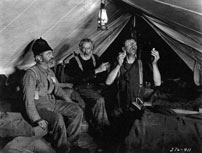
Fig. 5: George Cooper, Tully Marshall and Karl. |
|
| |
”The Great Dane and The Amazing Arthur”
In addition to appearing in films solo, MGM also paired Karl with short British comic George K. Arthur (fig. 6). The comedy team Dane & Arthur, also known as The Great Dane and the Amazing Arthur, were often cast as adversaries in their films: Arthur was the spoiled, somewhat effeminate, but smarter of the duo, and Karl was the big, lumbering bully who was his rival for the same girl. Usually, it was the more sympathetic Arthur who won love at the end, leaving Karl heartbroken and chastened, but with a new respect for his old enemy. Their first film together was the Army-themed Rookies (1927) (fig. 7), which began this popular comedy formula. They continued to use this formula successfully for their next five features together, all of which earned good profits for MGM.
In 1927, at the height of Karl’s fame, the first talking pictures were released. There was considerable anxiety at the studio since no one knew if this medium was a passing fad or something here to stay. Nothing is known about how Karl reacted to this new phenomena or whether he made any plans to protect himself since he had a foreign accent and was therefore more vulnerable than others.
In any case, Karl made his own talking debut rather late in the era, in 1929’s sailor-themed Navy Blues again directed by Clarence Brown and co-starring William Haines. In this film, despite being portrayed as rather gullible, Karl’s character ”Swede” proves a valuable friend to fellow sailor Kelly (Haines), when he assists in “rescuing” Kelly’s girl from a snooty club where she has become a hardened dime-a-dance hostess. In another example of Karl breaking societal rules and acting as an everyman, Swede rips the chandelier out of the ceiling and proceeds to use it as a weapon against the club’s haughty patrons (fig. 8).
Navy Blues received fine reviews and only a bare mention was made of Karl’s character “speaking with a decided Swedish (sic) accent.” Nonetheless, his roles became fewer and less distinguished into 1930. Almost as if the studio heads were frightened of risking public reaction, they cast Karl in either stereotypical roles or parts with no lines at all. A good example of this was The Big House from that year, in which Karl was featured prominently with the other actors, but said not one word. It was an ominous sign. In fact, MGM dropped Karl’s option that year, despite his having signed a “long-term” contract.
The Beginning of the End
Sadly, there would be no more challenging roles for Karl: just a series of shorts with his partner George K. Arthur at other studios, followed by a serial. It was as if everyone had forgotten the great reviews he had received only a few short years before. Now, Karl seemed hopelessly out of fashion, as if he was a figure out of the last century rather than the star he had been just a couple of years before.
His last role, in the serial The Whispering Shadow (1933) was an ironic one. He portrayed Sparks, the seemingly dimwitted and even lovable dispatcher at a firm being terrorized by an anonymous and murderous crime boss. Sparks was perhaps Karl’s most truly child-like character, forever playing with a little puzzle toy, and being brow-beaten by the other characters. Little did they know that he was in fact the malevolent Whispering Shadow himself, who would finally be unmasked in the final chapter! It is tempting to write off Karl’s performance in this low-budget serial, given its creakiness and fellow co-star Bela Lugosi’s overacting. However, flickers of Karl’s still-vital talent shine through, even with the poor material he had to work with: later on in the serial, after Sparks is unmasked as the villain, several scenes are repeated and what was at first assumed to be comic innocence is now revealed as something uncomfortably sinister. Karl’s easygoing amble down the hallway, whistling and playing with his toy, his method of delivering a deathly radio ray to his enemies, still sends a slight chill down the spine.
Given that Karl was then on a downward spiral, one cannot help but see certain parallels between him and his character. Like the Shadow, Karl’s intelligence and talent tended to be underestimated by his peers in Hollywood, and he tended to hide his growing pain and isolation. |
|
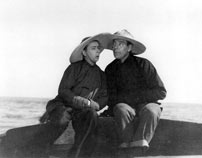
Fig. 6: George K. Arthur.
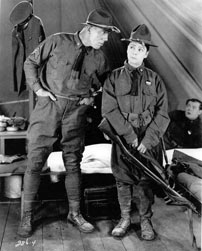
Fig. 7: With George K. Arthur.
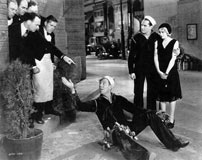
Fig. 8: Karl, William Haines, and Anita Page. |
|
| |
After Karl’s death, his name and contributions were neglected for many years. However, he was never entirely forgotten. In the 1960s, a Star was placed in his honor on the Hollywood Walk of Fame (fig. 9) . Also, his battered grave marker was myseriously replaced by a new one about 20 years ago. His best film, The Big Parade, is shown frequently at film festivals, and his brilliant, finely-shaded portrayal of Slim, goofy and endearing, yet also tragic, is still widely admired, even beloved, by modern audiences.
In conclusion, despite his untimely and sad end, Karl has managed to achieve a type of immortality, affection, and respect from new generations of silent film fans. Far from falling victim to the stereotypical characters written for him, Karl imbued them with a freshness and three-dimensional quality that transcended his material. This alone allows him to join the ranks of the true stars of the silent screen. |
|

Fig. 9: Karl Dane in the Hollywood Walk of Fame. Photo by Dan Balogh. |
|
 |
 |
 |
 |
 |
|
 |
 |
 |
| |
Facts
Statens Arkivers Arkivalieronline, courtesy Hugh Watkins.
LAK Archives, Copenhagen, courtesy Hugh Watkins.
1920 US Federal Census Records.
1917 US Draft Registration Records.
Ellis Island Passenger Records.
Los Angeles Times Archives.
Politiken, 1928 and 1934, courtesy Christian Hansen, Danish Film Institute.
Daily Production Reports for Dane & Arthur films, MGM Collection, Cinema-Television Library.
Doheny Library, University of Southern California , courtesy Ned Comstock.
Bent Harsmann.
Per Schøler Gottlieb.
www.karl-dane.com
Lunde, Arne. “Garbo Talks!: Scandinavians in Hollywood, the Talkie Revolution, and the Crisis of the Foreign Voice” in John Fullerton (ed.). Screen Culture: History & Textuality (Eastleigh: John Libbey, 2004): 21-40. See page 30. |
|
|
|
|
 |
 |
 |
 |
16:9 - april 2008 - 6. årgang - nummer 26
Udgives med støtte fra Det Danske Filminstitut samt Kulturministeriets bevilling til almenkulturelle tidsskrifter.
ISSN: 1603-5194. Copyright © 2002-08. Alle rettigheder reserveret. |
11 |
|
|
 |
 |
|
|